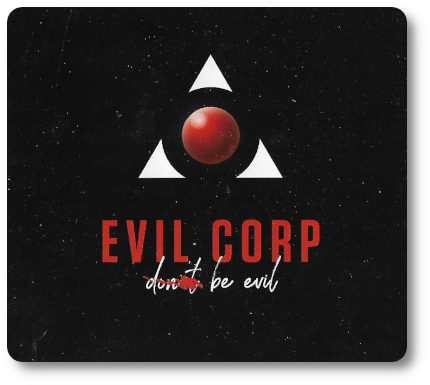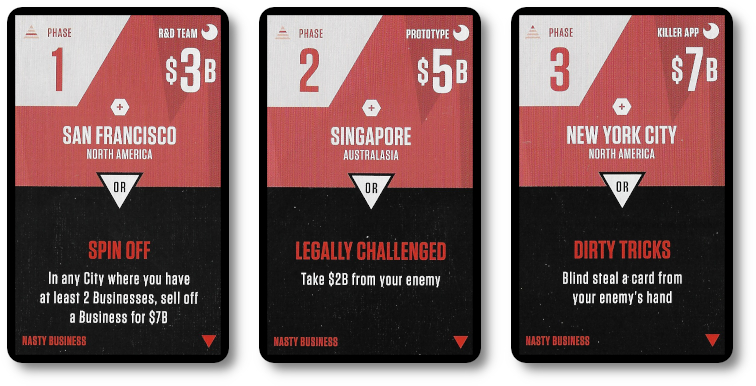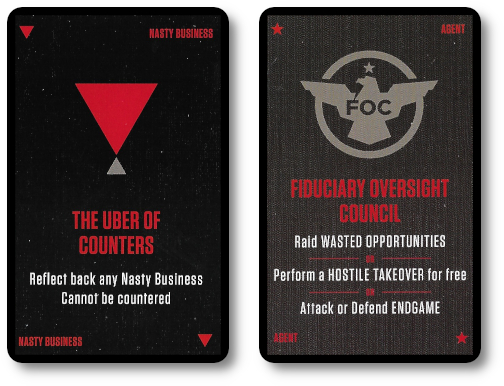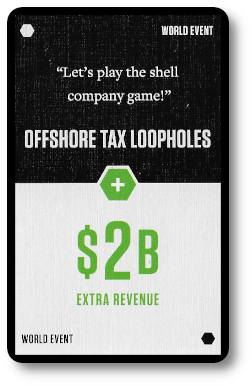
The Basics:
- For ages 13 and up
- For 2 to 6 players
- Approximately 90 minutes to complete
Geek Skills:
- Active Listening & Communication
- Counting & Math
- Logical & Critical Decision Making
- Reading
- Color Matching
- Strategy & Tactics
- Hand/Resource Management
Learning Curve:
- Child – Moderate
- Adult – Easy
Theme & Narrative:
- Quietly taking over the world through corporate power
Endorsements:
- Gamer Geek approved!
- Parent Geek approved!
- Child Geek approved!
Overview
American business magnate and philanthropist John D. Rockefeller said: “Don’t be afraid to give up the good to go for the great.” Which is to say, take risks to become exceptional. Good advice, but in this game, the CEOs you will play misinterpreted Mr. Rockefeller’s wisdom. They are most certainly giving up the good to become great, but by doing so, they are also – purposely – taking evil and selfish paths to obtain power and influence over the market and the world. Join in on the fun as you build your empire and rule the world from your comfy corner office.
Evil Corp, designed by Alfie Dennen, Allix Harrison and published by Newbie Games Company, is comprised of one hexagonal board (with centerpiece), one custom “Word Die,” six CEO Endgame cards, six CEO Power cards, 61 Opportunity cards, 20 World Event cards, 72 “Billion” Dollar Bills, 72 Business tokens (in various colors), 18 “Evil Lair” components, six Bankrupt tokens, six Quick Guide instruction cards, and one CEO icon sticker sheet which is used to make some of the game elements easier to see. The game components are of high quality, either made of thick cardboard, plastic, or a durable playing card. The one exception is the Dollar Bills, which are made of thin laminated paper (all kinds of not durable).
Starting Your Company
To set up the game, first assemble the board, which comes in six different pieces. These snap together like a puzzle creating a large hexagonal board. The plastic centerpiece is placed in the middle.
Second, place the stack of Dollar Bills in the centerpiece slot. This slot is referred to as the “Bank.”
Third, shuffle the Opportunity and World Event cards separately and place them face-down in the centerpiece.
Fourth, place the tokens and die off to one side of the game playing area.
Fifth, determine who will go first. There is no advantage to going first, but do note that this selection will determine the turn order sequence.
Sixth, starting with the first player and going in turn order sequence, each player selects a CEO card and takes the matching colored Business tokens and the three pieces of the Secret Base. These are placed in front of the player, face-up. Each CEO card is almost identical except for the “How to Win” requirements. These requirements, however, are similar to each other CEO except for the colored cards they need to play. My point being, no CEO has any advantage over the other. As such, don’t let the turn order suggest that the first player has an advantage.
Seventh, give each player their colored CEO Power cards. These cards are personal to the CEO the player has selected. They can be played in the game, but only once.
Eighth, have each player place their three Business pieces on three different cities in three different markets (wherein a “market” is any section of the game board with the noted cities). Note that any city is considered a “free-trade hub,” meaning it will host any number of Business pieces from different players.
Ninth, give each player their starting funds and opportunities. Take from the Bank 5 “Billion” Dollar Bills for each player and deal three Opportunity cards.
That’s it for game set up—time to rule the world from behind your office desk.
Building Your Empire
Evil Corp is played in rounds and turns with no set number of rounds per game. A player’s turn is organized into stages which are summarized here.
Stage One: Collect
During this stage of the player’s turn, their Secret Base and various businesses will generate much-needed resources. The amount given to the player from the Bank is one “Billion” for every Business they have on the game board and two “Billion” for their Secret Base. Note that the market prices will fluctuate during the game, but these world events can be ignored if they have a monopoly. A “monopoly” is completed if the player has one of their Businesses in each of the three cities in a market. If they do, players get to double their revenue (as well as ignore World Events).
The preferred practice is for the player to calculate their net worth for the collection and announce it to the table. This allows the player’s opponents to determine if the player is making miscalculations or using what I like to call “fuzzy math.” If the player’s opponents believe the player is making a mistake, they can force them to go through an “Audit.” And to be fair, the “Audit” is an action that any player can put on another at any time during the game, and not just when they think their math is off. If a player thinks an opponent is cheating, they can trigger an “Audit.”
If an “Audit” is called, the player who is being audited must prove their net worth. If they do, the opponent who triggered the “Audit” owes the player two “Billion” Dollar Bills. If the player is found to be fraudulent, they pay the opponent who triggered the “Audit” two “Billion” Dollar Bills.
Players can also collect what is referred to as “free opportunities” during this stage. This is generated by the player’s Secret Base, which gives the player one or more Opportunity cards per turn. Before the player draws their free Opportunity card, they can discard any they might have. After which, the player then collects the number of Opportunity cards needed up to their hand size limit. A player’s hand size limit fluctuates during the game (starting at “3” with a maximum of “6”) and is determined by the size of the player’s Secret Base. Players will have different hand sizes as a result, which can also be audited.
Stage Two: Spend
Now that the player has all that wealth burning a hole in their proverbial pocket, it’s time to spend it to increase their corporate empire’s reach and influence.
There are several actions a player can take here, and they are no limits to the number of actions the player can take as long as they can pay for them or have cards to play.
Lay a Phase
This action allows the player to play an Opportunity card with a phase number. It need not match the color of their CEO. Once paid for, the player places their Opportunity card in front of them, face-up, and places a Business in the identified city. This also allows the player to build their Secret Base. It’s important to note here that a player can play any colored Opportunity card for the phase, allowing them to place a Business and build to their Secret Base location. However, the player can only work towards their endgame if they play their color.
Players can only have one phase of each phase number. For example, you cannot have two “Phase One” opportunity cards in play simultaneously. Likewise, a player cannot play the next phase value unless they have the previous value. For example, the player cannot play a “Phase Two” until they have a “Phase One” in play. The player can replace cards in play, and by doing so, can get a business in a new city. Replacing the Opportunity card phase value does not remove previously placed businesses in that city. Opportunity cards no longer in use or resolved as single actions are discarded.

Perform Hostile Takeover
If an opponent has a phase of the player’s color, they can attempt a hostile takeover. To do so, the player can take two different approaches. First, they can pay for the phase color matching their CEO color (using the card’s price). Once paid for, the Opportunity card goes into the player’s hand.
Second, they can play a hostile agent.
Play Nasty Business or Agent Cards
Opportunity cards will allow a player to take the “Or” action for the phases, giving the player the ability to resolve a bit of nasty business. These are little “hits” to the player’s opponent that slowly reduce the opponent’s control of the market and impact their revenue stream.
“Agent” Opportunity cards allow the player to complete a hostile takeover for free, placing the card into their hand. Agents can also be used to search through the discard pile and attack or defend during the endgame.

Buy More Opportunity Cards
The player can always buy more Opportunity cards. Each card costs three “Billion” Dollar Bills, which is first paid before the Opportunity card is drawn. Players should be careful, though, as they don’t want to spend all their money or have more cards than they can currently hold in their hand size (if they do, they could be audited!).
Stage Three: World Event
The final stage of the player’s turn is to draw a World Event card. These impact the market and other elements of gameplay. The card is drawn, read out loud, and then the World die is rolled to determine in which market the World Event card is placed. World Event cards remain in play in that market until replaced or removed. World Events in play in a market only impact players who have assets in that market when collecting revenue.

This completes the player’s turn, and the next player in turn order sequence now takes their turn, starting with stage one noted above.
Bankruptcy
Despite having what many would consider “evil self-interest,” you still operate under a code of obligation. A player must be able to pay off any debts. If they cannot, they are automatically considered in bankruptcy. This means the player takes a Bankrupt token and places it in front of them for all to see. During the player’s next turn, they cannot collect any revenue. At which point, the player flips the Bankruptcy token to the “rebranding” side. On the player’s following turn, the Bankruptcy token with “rebranding” shown is removed, and the player can again collect revenue.
Keep in mind that going bankrupt hits the player’s revenue, but it also offers protection. While in bankruptcy or rebranding, the player is immune to all actions that are a financial attack. Also, being bankrupt and rebranding doesn’t stop the player from gaining liquidity (Dollar Bills) through other means.
If the player enters their endgame, they are immune to bankruptcy for the duration of the game.
Triggering the Endgame and Beating Everyone to Ultimate Corporate Evil
Once a player has all three phases of their CEO’s color in play, they have triggered their endgame. The player pays the amount listed on the back of their CEO card (nine “Billion” Dollar Bills) and flips their CEO card over, revealing their evil plan to all.

The player becomes a huge target, and every opponent should attempt to attack the player using their Agents. To do so, they play them to the player’s CEO. If the player can defend against all attacks, they win the game! If not, they flip their CEO card back over. On their next turn, they can attempt to win again by paying the billions noted, with hopes that they can avoid being attacked.
To learn more about Evil Corp, visit the game’s website.
Final Word
 The Child Geeks had a lot of fun playing this game, taking the time to laugh with evil glee and monolog at every opportunity about how they would crush the world. More importantly, all our Child Geeks understood how to play with only a few hiccups, allowing them to jump in with a high level of confidence. Yes, they became frustrated and often, but the game is not so punishing that any of our Child Geeks felt put in a corner. In fact, what makes the game complicated is not the game itself but the opponents you play with. The more hostile and aggressive they are, the more hostile and aggressive your game will be. This turned out to be perfect, as it allowed the Child Geeks to have fun at their own speed. According to one Child Geek, “I had a lot of fun, and this game is so much better than Monopoly.” Another Child Geek said, “I liked how you slowly build your power until you are ready for the big take over.” After the last stock was traded and the last business was brutally taken over, the Child Geeks gave Evil Corp their full approval.
The Child Geeks had a lot of fun playing this game, taking the time to laugh with evil glee and monolog at every opportunity about how they would crush the world. More importantly, all our Child Geeks understood how to play with only a few hiccups, allowing them to jump in with a high level of confidence. Yes, they became frustrated and often, but the game is not so punishing that any of our Child Geeks felt put in a corner. In fact, what makes the game complicated is not the game itself but the opponents you play with. The more hostile and aggressive they are, the more hostile and aggressive your game will be. This turned out to be perfect, as it allowed the Child Geeks to have fun at their own speed. According to one Child Geek, “I had a lot of fun, and this game is so much better than Monopoly.” Another Child Geek said, “I liked how you slowly build your power until you are ready for the big take over.” After the last stock was traded and the last business was brutally taken over, the Child Geeks gave Evil Corp their full approval.
 The Parent Geeks also had a lot of fun. And as expected, the game was more intense, but so too was the table talk. Talking smack and making deals at the table is a big part of this game that isn’t really discussed in the rules to a level I would suggest it should. Do talk a lot. Do monolog. Do make shady deals at the table with your opponents. This game is all about getting ahead no matter how you can, but you need people to back you from time to time, too. Business makes for strange relationships, for certain, and this game is no exception. According to one Parent Geek, “I had a lot of fun. It’s an easy game to get and entertaining to play. Felt good to be bad!” Another Parent Geek said, “When I played with my kids, I kindly crushed them in a very business and loving mother kind of way. Not how I went about it with my husband and the neighbors. Totally different game, and that was a lot of fun.” When the final hostile takeover was complete, the Parent Geeks gave Evil Corp their enthusiastic and full approval.
The Parent Geeks also had a lot of fun. And as expected, the game was more intense, but so too was the table talk. Talking smack and making deals at the table is a big part of this game that isn’t really discussed in the rules to a level I would suggest it should. Do talk a lot. Do monolog. Do make shady deals at the table with your opponents. This game is all about getting ahead no matter how you can, but you need people to back you from time to time, too. Business makes for strange relationships, for certain, and this game is no exception. According to one Parent Geek, “I had a lot of fun. It’s an easy game to get and entertaining to play. Felt good to be bad!” Another Parent Geek said, “When I played with my kids, I kindly crushed them in a very business and loving mother kind of way. Not how I went about it with my husband and the neighbors. Totally different game, and that was a lot of fun.” When the final hostile takeover was complete, the Parent Geeks gave Evil Corp their enthusiastic and full approval.
 The Gamer Geeks found Evil Corp to be light but entertaining. According to one Gamer Geek, “I enjoyed it. Fairly light and straightforward. Good interaction with the other players and just enough take-that to keep everyone at each others throats. I would play this again.” Another Gamer Geek said, “It doesn’t go into the economy, nor does it dip very deep into strategy or tactics. That said, what the game provides is solid fun. Easiest game of world domination I have ever played, but I would gladly play it again.” When all the votes were in, the Gamer Geeks made it rain with all those Billions, giving Evil Corp their full approval.
The Gamer Geeks found Evil Corp to be light but entertaining. According to one Gamer Geek, “I enjoyed it. Fairly light and straightforward. Good interaction with the other players and just enough take-that to keep everyone at each others throats. I would play this again.” Another Gamer Geek said, “It doesn’t go into the economy, nor does it dip very deep into strategy or tactics. That said, what the game provides is solid fun. Easiest game of world domination I have ever played, but I would gladly play it again.” When all the votes were in, the Gamer Geeks made it rain with all those Billions, giving Evil Corp their full approval.
 Seriously, they “made it rain,” which means they took all that play money and threw it up in the air. I wasn’t happy about that. Total mess, but my cat really liked it.
Seriously, they “made it rain,” which means they took all that play money and threw it up in the air. I wasn’t happy about that. Total mess, but my cat really liked it.
This is a game that puts you in the seat of an evil and misunderstood CEO. Yes, your objective is world domination, but the reasons behind it are not what I would consider real-world fiendish. Nor are they cartoony. There is goodness in the intent (sort of), but how the CEOs get to that result is not on morally solid ground. This allowed players to feel empowered to go after their goal without associating it with any real-world ongoings. It is an important point to make as we still live in an environment where political discussions are not comfortable with family members. Our economy is not as healthy as it once was. I mention this only to ensure you, dear reader, that you are not asked to play a role that directly ties to real-world events by playing this game. That’s important to some, and I’m sensitive to that.
With all that put aside, the game frees you up to go hog wild, chase those dark CEO dreams, and attempt to take over the world. In a very entertaining way, I might add—nothing cheesy or over the top. Instead, you do so with precise movement into markets, dominating the field and business world. Despite this being a game about large corporations, it’s most certainly a war. The battle is not fought with guns and soldiers but through finances and the ever overused audit.
And I do mean overused. A player can call an audit at any time. Mostly this is done to cause havoc, but it can be overused. The price you pay is not overly hurtful, giving players – especially early in the game – the ability to throw around the audit request freely. Towards the end of the game, when things get really expensive, the audit maneuver (as it has come to be called in my home) becomes a secondary concern. It is rightly so, too, as everyone is looking closely at their own budgets and less concerned over their opponents.
Table talk in this game is not mandatory, but it should be. In fact, I’d suggest you are playing the game wrong if you don’t drop the smack and makes some deals. This is a game about getting ahead anyway you can without being overly obvious about it. Subtly is the name of the game, and don’t think for a moment that the opponent saying they are happy to work for you have your intentions as their highest priority. They don’t, and they won’t hesitate to double-cross you. And that is a good thing because in this game only one player is the winner. Feel free to work with whomever you like, but there is only room for one butt in the winner’s chair.
Evil Corp makes being evil fun. True, nothing about this game is really “evil” (you aren’t selling people or working with shady governments to save money), but you certainly do feel like you are not necessarily on the straight and narrow, which is fun. Lots of fun. Do give this game a try when you get a chance. I bet your chase for world domination will be a great ride.
This game was given to Father Geek as a review copy. Father Geek was not paid, bribed, wined, dined, or threatened in vain hopes of influencing this review. Such is the statuesque and legendary integrity of Father Geek.
Discover more from Father Geek
Subscribe to get the latest posts sent to your email.





